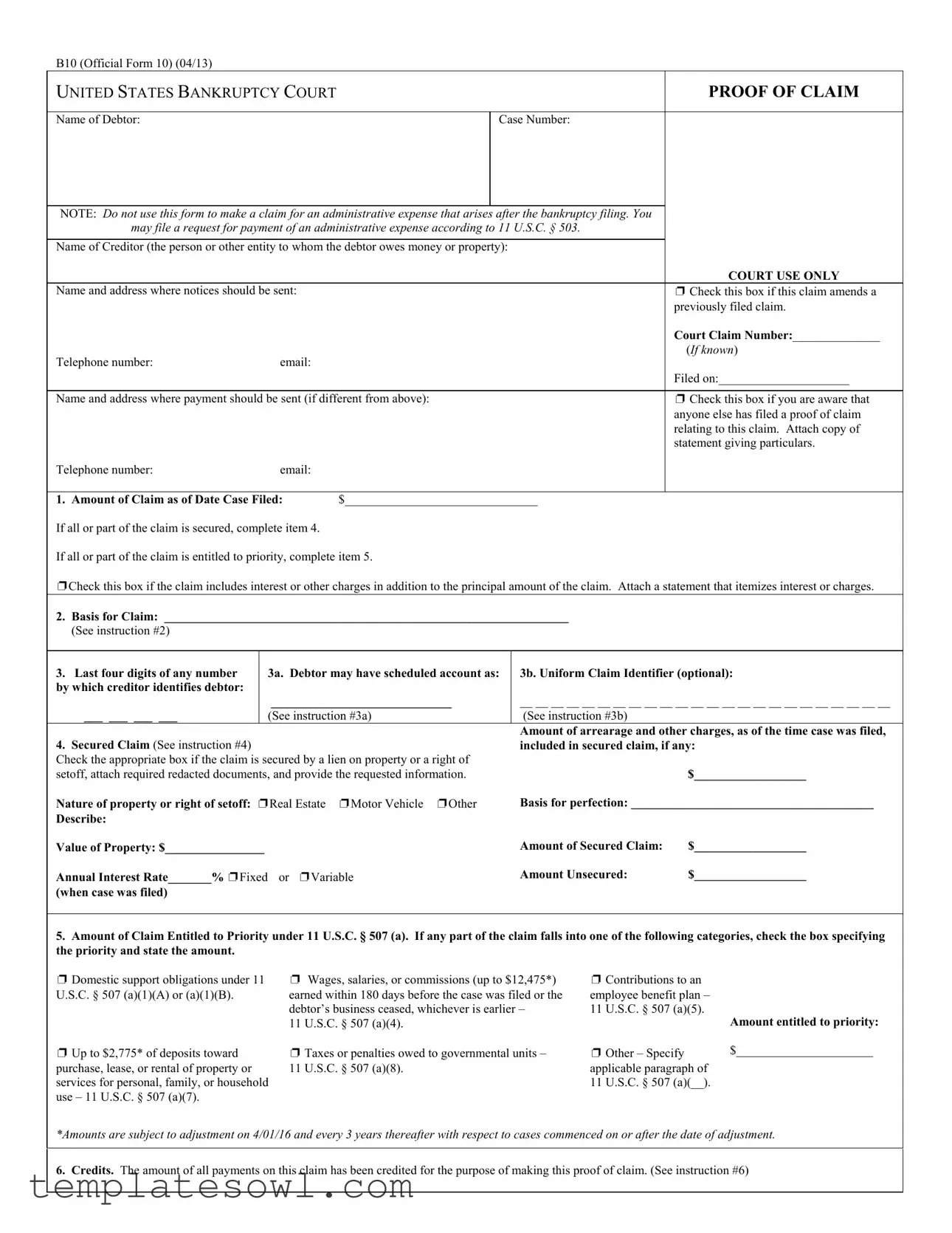DO NOT SEND ORIGINAL DOCUMENTS. ATTACHED DOCUMENTS MAY BE DESTROYED AFTER SCANNING.
I declare under penalty of perjury that the information provided in this claim is true and correct to the best of my knowledge, information, and reasonable belief.
The instructions and definitions below are general explanations of the law. In certain circumstances, such as bankruptcy cases not filed voluntarily by the debtor,
exceptions to these general rules may apply.
Court, Name of Debtor, and Case Number: |
claim is entirely unsecured. (See Definitions.) If the claim is secured, check the |
Fill in the federal judicial district in which the bankruptcy case was filed (for |
box for the nature and value of property that secures the claim, attach copies of lien |
example, Central District of California), the debtor’s full name, and the case |
documentation, and state, as of the date of the bankruptcy filing, the annual interest |
number. If the creditor received a notice of the case from the bankruptcy court, |
rate (and whether it is fixed or variable), and the amount past due on the claim. |
all of this information is at the top of the notice. |
|
|
|
5. Amount of Claim Entitled to Priority Under 11 U.S.C. § 507 (a). |
Creditor’s Name and Address: |
If any portion of the claim falls into any category shown, check the appropriate |
Fill in the name of the person or entity asserting a claim and the name and |
box(es) and state the amount entitled to priority. (See Definitions.) A claim may |
address of the person who should receive notices issued during the bankruptcy |
be partly priority and partly non-priority. For example, in some of the categories, |
case. A separate space is provided for the payment address if it differs from the |
the law limits the amount entitled to priority. |
notice address. The creditor has a continuing obligation to keep the court |
|
|
informed of its current address. See Federal Rule of Bankruptcy Procedure |
6. |
Credits: |
(FRBP) 2002(g). |
An authorized signature on this proof of claim serves as an acknowledgment that |
|
when calculating the amount of the claim, the creditor gave the debtor credit for |
1. Amount of Claim as of Date Case Filed: |
any payments received toward the debt. |
State the total amount owed to the creditor on the date of the bankruptcy filing. |
|
|
Follow the instructions concerning whether to complete items 4 and 5. Check |
7. |
Documents: |
the box if interest or other charges are included in the claim. |
Attach redacted copies of any documents that show the debt exists and a lien |
|
secures the debt. You must also attach copies of documents that evidence perfection |
2. Basis for Claim: |
of any security interest and documents required by FRBP 3001(c) for claims based |
State the type of debt or how it was incurred. Examples include goods sold, |
on an open-end or revolving consumer credit agreement or secured by a security |
money loaned, services performed, personal injury/wrongful death, car loan, |
interest in the debtor’s principal residence. You may also attach a summary in |
mortgage note, and credit card. If the claim is based on delivering health care |
addition to the documents themselves. FRBP 3001(c) and (d). If the claim is based |
goods or services, limit the disclosure of the goods or services so as to avoid |
on delivering health care goods or services, limit disclosing confidential health care |
embarrassment or the disclosure of confidential health care information. You |
information. Do not send original documents, as attachments may be destroyed |
may be required to provide additional disclosure if an interested party objects to |
after scanning. |
the claim. |
|
|
|
8. |
Date and Signature: |
3. Last Four Digits of Any Number by Which Creditor Identifies Debtor: |
The individual completing this proof of claim must sign and date it. FRBP 9011. |
State only the last four digits of the debtor’s account or other number used by the |
If the claim is filed electronically, FRBP 5005(a)(2) authorizes courts to establish |
creditor to identify the debtor. |
local rules specifying what constitutes a signature. If you sign this form, you |
|
declare under penalty of perjury that the information provided is true and correct to |
3a. Debtor May Have Scheduled Account As: |
the best of your knowledge, information, and reasonable belief. Your signature is |
Report a change in the creditor’s name, a transferred claim, or any other |
also a certification that the claim meets the requirements of FRBP 9011(b). |
information that clarifies a difference between this proof of claim and the claim |
Whether the claim is filed electronically or in person, if your name is on the |
as scheduled by the debtor. |
signature line, you are responsible for the declaration. Print the name and title, if |
|
any, of the creditor or other person authorized to file this claim. State the filer’s |
3b. Uniform Claim Identifier: |
address and telephone number if it differs from the address given on the top of the |
If you use a uniform claim identifier, you may report it here. A uniform claim |
form for purposes of receiving notices. If the claim is filed by an authorized agent, |
identifier is an optional 24-character identifier that certain large creditors use to |
provide both the name of the individual filing the claim and the name of the agent. |
facilitate electronic payment in chapter 13 cases. |
If the authorized agent is a servicer, identify the corporate servicer as the company. |
|
Criminal penalties apply for making a false statement on a proof of claim. |
|
|
|



